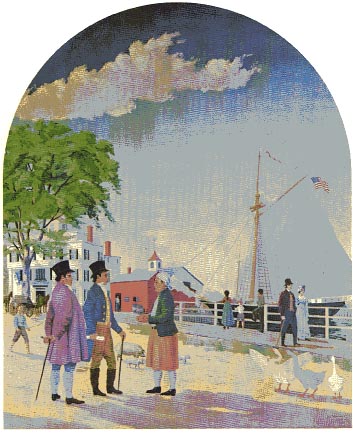Murals: Stamford scenes from yesteryear
 Canal
to the sound
Canal
to the sound
About 1842
In
the early 1830's the east branch of the Stamford harbor was extended to the
center of the town, and by means of a canal “brought sloop and West India
Brig navigation within ten rods of the meeting house in the center of the
town.”
Alfred Bishop,
a native Stamfordite, was a leader in the canal project. He was a canal and
railroad contractor and
was descended from the Reverend John Bishop, the successor to Reverend Richard
Denton in 1644. The canal was completed in 1833 and the first sloop to cleave
its waters was the “Mayflower”, Rufus Wardwell, Esquire, Captain.
The date of this Mural is about 1842
and shows the Stage House at the left. The Stage House was a thriving inn of
that time.
The canal followed the route later
taken by Canal Street. Sloops set sail from the terminal to Boston, New Haven,
New York, and the West Indies. They carried both passengers and cargo. Hides,
tanned leather, lumber, and potatoes were shipped from Stamford to these ports.
The sloops brought back from the West Indies dye woods, molasses and sugar.
Two years after
the canal was opened, the local paper “The Sentinel” thus spoke of its promise: “Through
the perseverance of a single individual, a ship canal had been opened and
the enterprising Messrs.
Wm. and R. Hoyt and Co. have dispatched the schooner “James Star” with a full
freight for the West Indies. The value of the canal to this vicinity is not
yet fully realized, but every day unfolds to the skeptic new evidences of
its
utility.”


Preface
Spring
of 1642: Settlers observe the Sabbath
About 1655: Setting the boundaries
October 1789: Townfolk greet George Washington
About 1842: Canal to the sound
Christmas Day 1848: First train to Stamford
Atlantic Street 1905
Stanley J. Rowland: About the artist
Image © The Stamford Historical Society

